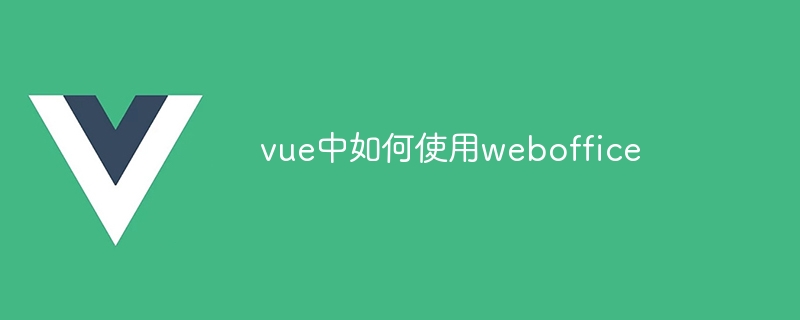How to use weboffice in vue
Using WebOffice in Vue involves: Installing dependencies, registering components, and using access APIs in components. WebOffice provides functions such as document viewing, editing, collaboration, annotation, version control, and integration, improving the document processing capabilities of Vue applications.

Using WebOffice in Vue
How to use WebOffice?
Using WebOffice in a Vue application involves the following steps:
1. Install dependencies
<code>npm install @nebulae/weboffice</code>
2. Register Component
In the Vue.js entry file, register the WebOffice component:
<code>import Vue from 'vue';
import { WebOffice } from '@nebulae/weboffice';
Vue.component('web-office', WebOffice);</code>3. Use
in the Vue component , you can embed WebOffice using the <web-office> tag:
<template>
<div>
<web-office
ref="weboffice"
:url="fileUrl"
:options="options"
/>
</div>
</template>
<script>
import WebOffice from '@nebulae/weboffice';
export default {
components: { WebOffice },
data() {
return {
fileUrl: 'https://example.com/document.docx',
options: {
// WebOffice 配置选项...
}
};
}
};
</script>4. Access the API
You can use the reference of the component To access the WebOffice API:
this.$refs.weboffice.getApi().then(api => {
// 使用 WebOffice API...
});Features
WebOffice allows you to embed the following functionality in your Vue application:
- Documentation Viewing and editing:Supports various document formats, including Word, Excel and PDF.
- Collaboration: Allows multiple people to edit documents at the same time.
- Annotate and markup: Add annotations, highlights, and shapes to collaborate on comments.
- Version Control: Track document changes and revert to earlier versions.
- Integrations: Integrate with other third-party applications such as Google Drive and Dropbox.
By using WebOffice, you can seamlessly integrate advanced document processing capabilities into your Vue applications, improving collaboration and productivity.
The above is the detailed content of How to use weboffice in vue. For more information, please follow other related articles on the PHP Chinese website!

Hot AI Tools

Undresser.AI Undress
AI-powered app for creating realistic nude photos

AI Clothes Remover
Online AI tool for removing clothes from photos.

Undress AI Tool
Undress images for free

Clothoff.io
AI clothes remover

Video Face Swap
Swap faces in any video effortlessly with our completely free AI face swap tool!

Hot Article

Hot Tools

Notepad++7.3.1
Easy-to-use and free code editor

SublimeText3 Chinese version
Chinese version, very easy to use

Zend Studio 13.0.1
Powerful PHP integrated development environment

Dreamweaver CS6
Visual web development tools

SublimeText3 Mac version
God-level code editing software (SublimeText3)

Hot Topics
 1386
1386
 52
52
 How to use bootstrap in vue
Apr 07, 2025 pm 11:33 PM
How to use bootstrap in vue
Apr 07, 2025 pm 11:33 PM
Using Bootstrap in Vue.js is divided into five steps: Install Bootstrap. Import Bootstrap in main.js. Use the Bootstrap component directly in the template. Optional: Custom style. Optional: Use plug-ins.
 How to add functions to buttons for vue
Apr 08, 2025 am 08:51 AM
How to add functions to buttons for vue
Apr 08, 2025 am 08:51 AM
You can add a function to the Vue button by binding the button in the HTML template to a method. Define the method and write function logic in the Vue instance.
 How to reference js file with vue.js
Apr 07, 2025 pm 11:27 PM
How to reference js file with vue.js
Apr 07, 2025 pm 11:27 PM
There are three ways to refer to JS files in Vue.js: directly specify the path using the <script> tag;; dynamic import using the mounted() lifecycle hook; and importing through the Vuex state management library.
 How to use watch in vue
Apr 07, 2025 pm 11:36 PM
How to use watch in vue
Apr 07, 2025 pm 11:36 PM
The watch option in Vue.js allows developers to listen for changes in specific data. When the data changes, watch triggers a callback function to perform update views or other tasks. Its configuration options include immediate, which specifies whether to execute a callback immediately, and deep, which specifies whether to recursively listen to changes to objects or arrays.
 What does vue multi-page development mean?
Apr 07, 2025 pm 11:57 PM
What does vue multi-page development mean?
Apr 07, 2025 pm 11:57 PM
Vue multi-page development is a way to build applications using the Vue.js framework, where the application is divided into separate pages: Code Maintenance: Splitting the application into multiple pages can make the code easier to manage and maintain. Modularity: Each page can be used as a separate module for easy reuse and replacement. Simple routing: Navigation between pages can be managed through simple routing configuration. SEO Optimization: Each page has its own URL, which helps SEO.
 How to return to previous page by vue
Apr 07, 2025 pm 11:30 PM
How to return to previous page by vue
Apr 07, 2025 pm 11:30 PM
Vue.js has four methods to return to the previous page: $router.go(-1)$router.back() uses <router-link to="/" component window.history.back(), and the method selection depends on the scene.
 How to query the version of vue
Apr 07, 2025 pm 11:24 PM
How to query the version of vue
Apr 07, 2025 pm 11:24 PM
You can query the Vue version by using Vue Devtools to view the Vue tab in the browser's console. Use npm to run the "npm list -g vue" command. Find the Vue item in the "dependencies" object of the package.json file. For Vue CLI projects, run the "vue --version" command. Check the version information in the <script> tag in the HTML file that refers to the Vue file.
 How to use function intercept vue
Apr 08, 2025 am 06:51 AM
How to use function intercept vue
Apr 08, 2025 am 06:51 AM
Function interception in Vue is a technique used to limit the number of times a function is called within a specified time period and prevent performance problems. The implementation method is: import the lodash library: import { debounce } from 'lodash'; Use the debounce function to create an intercept function: const debouncedFunction = debounce(() => { / Logical / }, 500); Call the intercept function, and the control function is called at most once in 500 milliseconds.




